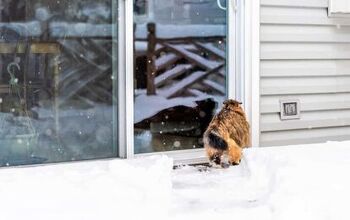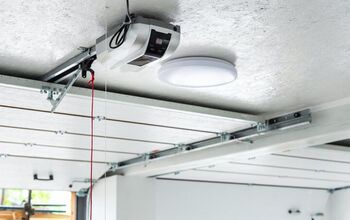How To Winterize A Sliding Patio Door (Step-by-Step Guide)

Sliding glass doors are a beautiful addition to any home; however, they can be a problem in the cold weather. These large windows can harbor all sorts of air leaks. These leaks make it harder to heat your home and will end up costing you a lot of money. Even if you have brand new sliding doors, there are several maintenance steps you should take before the cold weather hits.
Winterize your sliding patio door by cleaning the tracks, enforcing the seals, and investing in some insulating drapes. These steps don’t take long to perform. They will increase the life of your sliding door and keep you warm when the snow starts to fall.
In the sections below, we will give you a complete guide to winterizing your sliding doors. Taking some time now will save you money and keep you comfortable.
Here’s how you do it.
Do You Need Handyman Services?
Get free, zero-commitment quotes from pro contractors near you.

How To Fully Winterize Your Sliding Patio Door
The best part about these steps – they each help on their own. Even if you can only incorporate two or three of them, you will see positive benefits.
For instance, some people might still need to use their sliding door in the winter. They might not be able to use plastic wrap, but they could still install a set of thermal curtains. Do what works for you. And know that with every step, you’re saving money (and heat!).
Here are the seven steps:
- Clean the tracks and edge of your sliding patio door
- Install new lining/weather stripping to stop air leaks
- Install a pair of insulating blinds
- Re-caulk outside seams
- Use plastic wrap window kits
- Make an insulative panel from rigid foam
- Don’t forget about other areas of the window
Before you get started with these steps, be sure you have all the necessary equipment on hand. Having everything ready will save you time and energy.
Here is a list of needed equipment:
- Cleaning brush and sponge
- Hydrogen peroxide and Lysol cleaner for track
- New weather stripping – make sure you get a long enough strip!
- New blinds (optional)
- Rigid foam insulation board
- Vacuum to clear debris from the track
Alright, now that you have everything you need, let’s insulate that sliding door.
Step 1: Clean the Tracks and Edges of Sliding Patio Door
Unlike a threshold like a traditional door, sliding doors have tracks. And tracks collect dirt and grime like a squirrel collects nuts. Even in the summer, you should make cleaning your tracks part of your routine.
When tracks go untended, pebbles and dust can prevent the door from creating an airtight seal. As a result, you get air leaks.
Here’s how you fix it.
First, take your vacuum and attach it with a narrow hose fitting. Then, go around the edges and tracks of your sliding door and clean as much dirt as possible. Gently open and close your door several times to help stir up latent grime, then proceed to vacuum it up again. Do this until there is nothing else to vacuum.
Then, take your cleaning solution and spray the tracks and edges. Use your cleaning brush and sponge to sop up the filth. Do this until the track sparkle. Be sure to dry any moisture.
Note: don’t just clean the track under the sliding door, also clean the track the door slides into when you open it. If one side is dirty, it will pull grime to the other.
Step 2: Install New Weather Stripping
Weatherstripping can help fill those micro gaps. Air will sneak through the smallest opening. To stop this, arm yourself with a quality weather stripping.
First, for the best seal, make sure the area is clean. Then, take your weather stripping and carefully place it along the seam of the door. When you do this, just be careful that you don’t get any sticky substance down into the door tracks, as this will hinder it from being opened next spring and will attract dust.
Weatherstripping can also be used on windows.
Step 3: Install Insulating Curtains
A good set of curtains can serve multiple functions. It will keep you warm in the winter, cool in the summer, provide privacy, and they can add a cozy look to your home. You can spend as much or as little as you’d like on a set of curtains. Regardless, a thick pair of insulating curtains can be of huge benefit in the wintertime.
When installing them, follow the curtain manufacturer’s recommendations. Also, be sure you get a curtain rod that is sturdy enough the hold the weight of the dense curtains.
Step 4: Re-Caulk Outside Seams
Sliding patio doors are subject to more vibration than other windows. Sometimes unknowing children will slam them open and closed. As a result, it’s not uncommon for the outside seals to be disrupted.
Inspect the caulk line outside your sliding door. If it has become damaged, consider re-caulking the seam. If you are unsure of your ability to caulk around a sliding door, don’t hesitate to consult a professional. This problem is more common in older sliding doors that have been subject to several seasons of freezing temperatures.
Step 5: Use a Plastic Wrap Window Kit
Covering your window with plastic wrap can be a great way to virtually eliminate drafts. If you don’t plan to use your sliding door during the winter, this can be a cheap and effective option.
Read instructions to install your kit. Each one can have a different method of placement. Some will have you install long clips so that you can easily install and remove them when needed. Others use an adhesive and a heat source – usually a hairdryer – to secure the plastic over the window.
There have been some people who use bubble wrap. Granted, it’s an obvious eyesore, but if you are having many problems with sealing an old sliding patio door, it might be worth it. For a more in this, see our article explaining how to place plastic on a window.
Step 6: Insulate Sliding Door Using Rigid Foam
This is a good idea if you’ve been having a lot of problems with insulation. Perhaps you have an old sliding door, or maybe you get extremely cold temperatures. Regardless, you can create a great seal using rigid foam insulation.
To do this, you will need a large sheet of foam insulation. These can be found at any major home improvement store.
To create your insulator, measure the space you’d like to place the foam. Then, try to cut the foam board as exactly as possible. A snug fit will ensure the best protection from the cold weather. If you only want to use this on extremely cold days, you can take it out on warmer days and store it when the sun is shining.
Also, if you don’t like the look of a large sheet of foam, you can paint the board a neutral color to make it easier on the eyes.
Step 7: Don’t Forget other Parts of Sliding Window
Remember that glass itself is not the best insulator. Usually, a sliding door has at least two panes – many have three. Even after you’ve sealed around the door, make sure to take a moment and assess the other parts of the window.
You may want to great a foam board insulation piece to cover every section of the window. You don’t need to keep these in all the time, but it’s nice to have them on the cold nights.
Remember what we said initially – even if you can’t perform all these steps, at least doing some of them will drastically increase your ability to keep warm air in and cold air out.
Do You Need Handyman Services?
Get free, zero-commitment quotes from pro contractors near you.

Related Questions
Drafts come from direct openings from the inside of a window to the outside. To repair this, you need to start by cleaning out the track your sliding doors move on. Second, you need to apply weather stripping around the edges. This will drastically limit the amount of air moving into your home. See the article above for more details on all these steps.
How Do I Make My Sliding Glass Door Slide Easier?Your sliding glass door isn’t sliding because there is debris built up within the track. To remedy, you’ll need to start by vacuuming all obvious dirt and pebbles from the track. Second, you should use a cleaning solution to scrub as much grime out of the cracks as you can. Third, try a lubricant to help the wheels slide freely upon the track. If you still can’t get the door to slide, consider hiring a professional or replacing the door.
How to Seal Sliding Glass Door with Dog Door?Follow all the steps listed to seal a sliding door in the article about. This means clearing the tracks and installing weather stripping. A set of insulating curtains would also benefit the sliding door. For your dog door, you’ll want to completely seal the edges of the door. Also, you may want to cover the dog door with a foam insulation board. See this article for more information on winterizing a dog door.

Gideon is a writer and hobby woodworker. He enjoys working on projects small and large-everything from crafting boxes and benches, to replacing carpet and landscaping a yard.
More by Gideon Zielinski

















![Cost To Drill A Well [Pricing Per Foot & Cost By State]](https://cdn-fastly.upgradedhome.com/media/2023/07/31/9074980/cost-to-drill-a-well-pricing-per-foot-cost-by-state.jpg?size=350x220)









